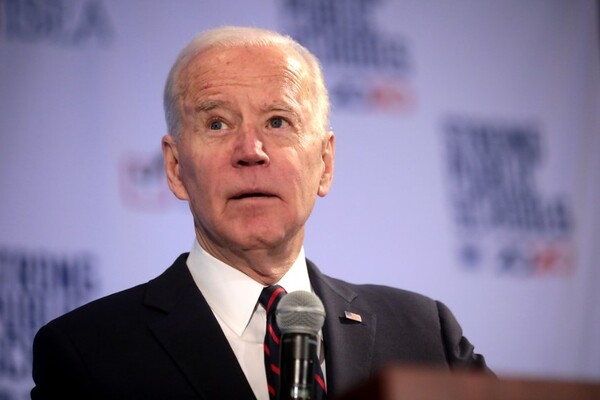
(function(d, s, id) { var js, fjs = d.getElementsByTagName(s)[0]; if (d.getElementById(id)) return; js = d.createElement(s); js.id = id; js.src = “https://connect.facebook.net/en_US/sdk.js#xfbml=1&version=v3.0”; fjs.parentNode.insertBefore(js, fjs); }(document, ‘script’, ‘facebook-jssdk’)); –>
–>
February 9, 2024
It’s Super Bowl week, and one of many hyped events now surrounding the game has become the customary media interview with the sitting American president. But President Joe Biden — or, maybe more correctly, his handlers — has passed for the second year in a row on this prime opportunity, this time in an election year, to plug his agenda and record. Before these two years, the annual Super Bowl interview with the president was watched by tens of millions of viewers.
‘); googletag.cmd.push(function () { googletag.display(‘div-gpt-ad-1609268089992-0’); }); document.write(”); googletag.cmd.push(function() { googletag.pubads().addEventListener(‘slotRenderEnded’, function(event) { if (event.slot.getSlotElementId() == “div-hre-Americanthinker—New-3028”) { googletag.display(“div-hre-Americanthinker—New-3028”); } }); }); }
The presidential Super Bowl interview began as a yearly event with Barack Obama in 2009. Former presidents including George W. Bush and Bill Clinton also did interviews tied to the Super Bowl, though not annually. While last year’s choice to forgo an interview with Fox News can be written off due to ongoing rancor between Democrats and the conservative outlet, this year’s decision to skip the large platform of a dialogue with a friendly CBS in an election year continues a Biden record of doing fewer press appearances than previous commanders-in-chief. Since entering office, he has done 86 interviews versus 300 for Trump and 422 for Barack Obama at this juncture in their presidencies, per data assembled by The White House Transition Project.
Press avoidance has been President Biden’s modus operandi since before taking office. After campaigning from his basement, it took President Biden until late March 2021 to hold his first press conference, more than two months after his inauguration and the longest in a century that a new president had gone without holding a press conference. In 2023, Biden did not conduct a solo news conference with reporters, and he has yet to do one in 2024.
For his last solo press conference at the White House, customarily open to the entire press corps, one must go back to November 9, 2022, after the midterm elections. Even more concerning should be that the U.S. president declines speaking with any reporter not on a short, pre-approved White House list.
‘); googletag.cmd.push(function () { googletag.display(‘div-gpt-ad-1609270365559-0’); }); document.write(”); googletag.cmd.push(function() { googletag.pubads().addEventListener(‘slotRenderEnded’, function(event) { if (event.slot.getSlotElementId() == “div-hre-Americanthinker—New-3035”) { googletag.display(“div-hre-Americanthinker—New-3035”); } }); }); }
This obvious, visible, and extraordinarily tight control on President Biden’s interactions with the press belies a palpable fear and trepidation in his White House handlers of his abilities and what he might say (or not) or do if put in a position requiring him to speak extemporaneously and without aids such as a teleprompter or notecards. Advisers come across as wanting no part of the press conference format, which can be both thorough and uncomfortable (if journalists do their jobs).
More signs of his staff’s fear and control abound. A White House staffer dressed as the Easter Bunny hovered close to the president to usher him away from White House guests when he began speaking with them. His wife, Jill Biden, walked him away from reporters when asked about classified documents. Carefully scripted note cards with instructions for what to do and say for most every move are ubiquitous. He frequently departs from an event podium or forum without taking questions. If he does take questions, he is apt to call on only preselected reporters from — in his own words — “a list I’ve been given.”
The president has also developed a bad habit of not being available to the press during visits with foreign leaders. While “joint pressers” — “two-by-twos” in the jargon — are not held with every head of state visit, it is uncommon not to offer one when a key ally visits the U.S. To wit, the president declined to host a joint press conference for German chancellor Olaf Scholz’s visit to the White House last spring and didn’t conduct press conferences with visiting U.K. prime minister Rishi Sunak and Australian prime minister Anthony Albanese in San Diego last March, or with Brazil’s President da Silva last February. He would ignore and even laugh off press questions at a St. Patrick’s Day 2023 meeting with visiting Irish leader Leo Varadkar — refusing to engage despite major ongoing events.
Last fall, the White House was taken to task for presidential press secretary Karine Jean-Pierre abruptly ending his news conference in Hanoi, Vietnam, at one point taking a microphone to announce that the event had ended even as the president was still answering reporters’ questions in the room.
The American public perceives that something is not right. It is obvious that it is not just grumblings from White House reporters having to make deadlines that President Biden is too frequently kept from publicly answering questions. There is no hiding that Mr. Biden is gaffe-prone and that news conferences are not his strong suit. But if he is a candidate for a second term, he should be eager to demonstrate he can handle all aspects of the job. Answering media’s questions promotes public accountability and establishes that a president is willing to defend his policies and decisions.
Is it too big a lift for President Biden to sit down with the press — deputized for the American public — and answer their pointed questions? Then for him to expound on his policies and decisions with the “whys” while speaking in his own words, sans teleprompters, note cards, and hovering aides? It is not unreasonable for Americans to expect a periodic dialogue — not a scripted speech, but a conversation with the president — to tell us where he is taking this nation. After all, the issues are as big and important as ever — our borders, the economy, wars in Ukraine and the Middle East, tensions in the Pacific, energy, education, crime, immigration, taxes, national security, government spending, or [fill in the blank].
‘); googletag.cmd.push(function () { googletag.display(‘div-gpt-ad-1609268078422-0’); }); document.write(”); googletag.cmd.push(function() { googletag.pubads().addEventListener(‘slotRenderEnded’, function(event) { if (event.slot.getSlotElementId() == “div-hre-Americanthinker—New-3027”) { googletag.display(“div-hre-Americanthinker—New-3027”); } }); }); } if (publir_show_ads) { document.write(“
Given his responsibilities as the nation’s chief executive, he should be able to meet questions with comprehensive, reasoned, and considered answers on his own. Likewise, voters — especially in an election year — should expect the president of the United States to be energetically engaged and conversing with the American people.
Right now, Biden’s handlers must know that they are proverbially on one of those “horns of a dilemma,” neither of which is a good look for the president. They play it safe and keep him from doing a Super Bowl interview, petrified by what he might do or say, while, on the other hand, they know that Americans sense that if he is not visible as a candidate — even as the incumbent — their doubts justifiably multiply, and any support wanes.
Ultimately a public servant, with a paycheck signed by the American taxpayer, a president — any president — is derelict in his duty and lacking accountability to the American people if he refuses to “meet the press” — even on Super Bowl Sunday.
Colonel Chris J. Krisinger, USAF (ret.) served a tour as military adviser to the undersecretary of state for public diplomacy and public affairs at the Department of State. He is an honors graduate of the U.S. Naval War College and was also a National Defense Fellow at Harvard University. If you would like to continue the conversation, contact him at: [email protected].

Image: Gage Skidmore via Flickr, CC BY-SA 2.0.
<!–
–>
<!– if(page_width_onload <= 479) { document.write("
“); googletag.cmd.push(function() { googletag.display(‘div-gpt-ad-1345489840937-4’); }); } –> If you experience technical problems, please write to [email protected]
FOLLOW US ON
<!–
–>
<!– _qoptions={ qacct:”p-9bKF-NgTuSFM6″ }; ![]() –> <!—-> <!– var addthis_share = { email_template: “new_template” } –>
–> <!—-> <!– var addthis_share = { email_template: “new_template” } –>





